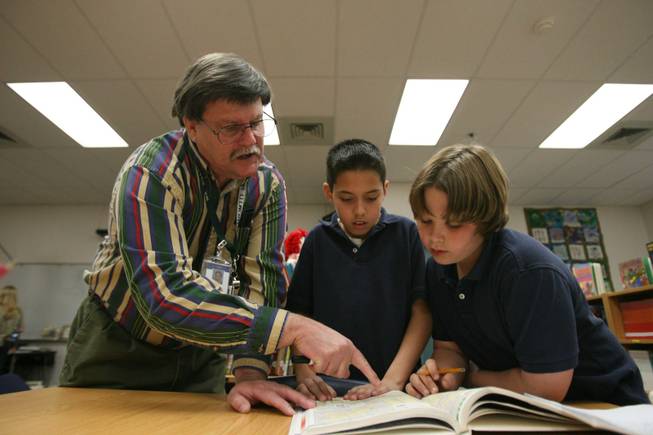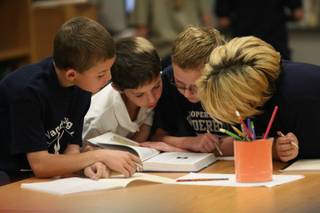
Richard Brian / Special to the Sun
GATE instructor William Gilluly works with Vanderburg Elementary school fourth graders Kristian Thymianus, center, and David Shipley, both 10.
Wednesday, April 22, 2009 | 2:44 p.m.
Children don't have to be gifted to think outside the box. And they don't have to be talented to benefit from a challenge, some Clark County educators believe.
Henderson-area teachers in the Gifted and Talented Education program, or GATE, are taking techniques they use with the children deemed the best and brightest into the classrooms of everyone else.
"We want to do more than teach to the test," Hilary Hassenzahl, GATE teacher at Roberta Cartwright and Robert Taylor elementary schools said. "At the same time, we reach a deeper level of the curriculum."
Helping regular classroom teachers has always been part of the GATE teacher job description, Lora McHugh, GATE coordinator for the Southeast Region, said. It's called collaborative co-teaching.
But the efforts in the Southeast Region, which includes Henderson, are gaining the notice of Clark County School District administrators.
"They are carving out time, because it's important to us," said Patsi Johnson, assistant superintendent for the Southeast Region.
The law requires 150 minutes a week of special instruction for gifted and talented children, but, Johnson said, "there are these extra minutes. We were asking what can we do within in the scope of the job to help all students?"
It's not that gifted and talented education is more difficult, said William Gilluly, GATE teacher at John C. Vanderburg Elementary School. Sometimes it's just a matter of rephrasing a question.
For example, he said, in a segment about immigration, a regular teacher may ask, "What was Ellis Island?"
He rephrases the question, "What if you were in charge of Ellis Island?"
"The regular students began to ask questions," Gilluly said. "They hear from parents and watch the news."
Hazzenzahl uses games to get students to think.
Some of those games teach algebra skills to elementary students, she said, "but we don't call it algebra until we are done."
Then, she said, "They have a positive feeling that it's not scary stuff but fun. It's playfulness with a purpose."
They key, said Miriam Kuzma, GATE teacher at James I. Gibson Elementary School, is modeling some of those techniques for the regular classroom teachers, so that they can incorporate them more often.
"We share the strategies in order to ensure all learners are taking thinking beyond the facts to further and deeper understand to conceptualize and to make necessary connections — to think critically," she said.
One way to do it is to have the GATE teacher conduct the lesson while the classroom teacher watches and learns, Kuzma said. Another is to have one teaching and the other roaming the classroom helping the students, or to divide the class into two and have each teacher work with a group.
At Gibson, the collaboration is focusing on writing skills to help children with the standardized testing, she said, but the hope is to have the effort felt all the way to high school. She and the school's administrators hope to help increase enrollment in the college-level International Baccalaureate program at Green Valley High School, she said.
Kuzma is working with a fifth grade teacher at Gibson to use Green Valley High students as mentors in the class to help the students explore an issue. The students chose capital punishment, she said, and learned about not only the issue, but also how to write their arguments, debate them, dress professionally and videotape the debate.
Hassenhahl also uses a more passive approach. She was doing a crime scene investigation unit with her GATE students at Taylor, where she teaches one day a week, before spring break. She left the simulated crime scene set up in her room and invited the regular classroom teachers to bring their children in for a self-guided tour.
"It was a way to reach out," she said. "You find ways even when the schedule is tight."


Join the Discussion:
Check this out for a full explanation of our conversion to the LiveFyre commenting system and instructions on how to sign up for an account.
Full comments policy